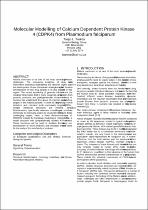 ResearchSpace
ResearchSpace
Molecular modelling of calcium dependent protein kinase 4 (CDPK4) from Plasmodium falciparum
JavaScript is disabled for your browser. Some features of this site may not work without it.
- ResearchSpace
- →
- Research Publications/Outputs
- →
- Conference Publications
- →
- View Item
| dc.contributor.author |
Tsekoa, Tsepo L

|
|
| dc.date.accessioned | 2009-12-08T13:55:56Z | |
| dc.date.available | 2009-12-08T13:55:56Z | |
| dc.date.issued | 2009-10 | |
| dc.identifier.citation | Tsekoa, T.L. 2009. Molecular modelling of calcium dependent protein kinase 4 (CDPK4) from Plasmodium falciparum. Annual Research Conference of the South African Institute of Computer Scientists and Information Technologists (SAICSIT). Vanderbijlpark, South Africa, 12-14 October 2009, pp 4 | en |
| dc.identifier.issn | 978-1-60558-643-4 | |
| dc.identifier.uri | http://hdl.handle.net/10204/3823 | |
| dc.description | Copyright: ACM 2009. This is the author's version of the work. It is posted here by permission of ACM for your personal use. Not for redistribution. The definitive version was published in Proceedings of the South African Institute of Computer Scientists and Information Technologists (SAICSIT) Conference, {978-1-60558-286-3, (2008)} http://doi.acm.org/10.1145/nnnnnn.nnnnnn | en |
| dc.description.abstract | Malaria continues to be one of the most serious global health challenges. The increasing incidence of drug resistant Plasmodium strains has emphasised the need for urgent action in the development of new therapeutic strategies against this disease. Development of new drug targets is of vital importance in this regard. The recent availability of genomic information and the resultant observation that in many instances, protein kinases from parasitic protozoa are phylogenetically distant from those in humans has established this group of enzymes as potential drug targets in the Malaria parasite. In order to rationally design novel inhibitors and chemical tools exclusively targeting CDPKs, reliable molecular structures are needed. Structural Bioinformatics, specifically molecular modelling, can contribute immensely to improving access to structural information for these challenging targets. Here, a three dimensional structure of PfCDPK4 created by homology modelling is reported. Further, a model structure with computationally docked ATP is created. These structures will be used to facilitate the discovery and development of novel inhibitors and chemical proteomics tools for the study of this sub-family of proteins. | en |
| dc.language.iso | en | en |
| dc.publisher | Association for Computing Machinery (ACM) | en |
| dc.subject | Plasmodium falciparum | en |
| dc.subject | Malaria drugs | en |
| dc.subject | Protein kinase | en |
| dc.subject | Structural bioinformatics | en |
| dc.subject | Malaria | en |
| dc.title | Molecular modelling of calcium dependent protein kinase 4 (CDPK4) from Plasmodium falciparum | en |
| dc.type | Conference Presentation | en |
| dc.identifier.apacitation | Tsekoa, T. L. (2009). Molecular modelling of calcium dependent protein kinase 4 (CDPK4) from Plasmodium falciparum. Association for Computing Machinery (ACM). http://hdl.handle.net/10204/3823 | en_ZA |
| dc.identifier.chicagocitation | Tsekoa, Tsepo L. "Molecular modelling of calcium dependent protein kinase 4 (CDPK4) from Plasmodium falciparum." (2009): http://hdl.handle.net/10204/3823 | en_ZA |
| dc.identifier.vancouvercitation | Tsekoa TL, Molecular modelling of calcium dependent protein kinase 4 (CDPK4) from Plasmodium falciparum; Association for Computing Machinery (ACM); 2009. http://hdl.handle.net/10204/3823 . | en_ZA |
| dc.identifier.ris | TY - Conference Presentation AU - Tsekoa, Tsepo L AB - Malaria continues to be one of the most serious global health challenges. The increasing incidence of drug resistant Plasmodium strains has emphasised the need for urgent action in the development of new therapeutic strategies against this disease. Development of new drug targets is of vital importance in this regard. The recent availability of genomic information and the resultant observation that in many instances, protein kinases from parasitic protozoa are phylogenetically distant from those in humans has established this group of enzymes as potential drug targets in the Malaria parasite. In order to rationally design novel inhibitors and chemical tools exclusively targeting CDPKs, reliable molecular structures are needed. Structural Bioinformatics, specifically molecular modelling, can contribute immensely to improving access to structural information for these challenging targets. Here, a three dimensional structure of PfCDPK4 created by homology modelling is reported. Further, a model structure with computationally docked ATP is created. These structures will be used to facilitate the discovery and development of novel inhibitors and chemical proteomics tools for the study of this sub-family of proteins. DA - 2009-10 DB - ResearchSpace DP - CSIR KW - Plasmodium falciparum KW - Malaria drugs KW - Protein kinase KW - Structural bioinformatics KW - Malaria LK - https://researchspace.csir.co.za PY - 2009 SM - 978-1-60558-643-4 T1 - Molecular modelling of calcium dependent protein kinase 4 (CDPK4) from Plasmodium falciparum TI - Molecular modelling of calcium dependent protein kinase 4 (CDPK4) from Plasmodium falciparum UR - http://hdl.handle.net/10204/3823 ER - | en_ZA |





